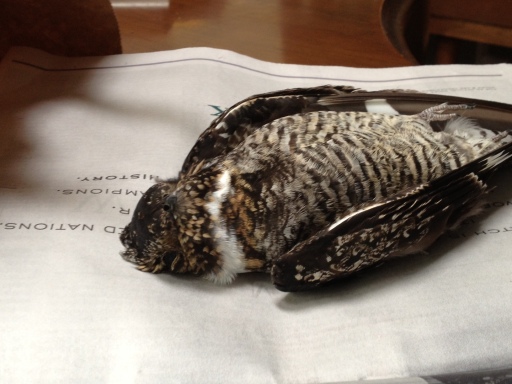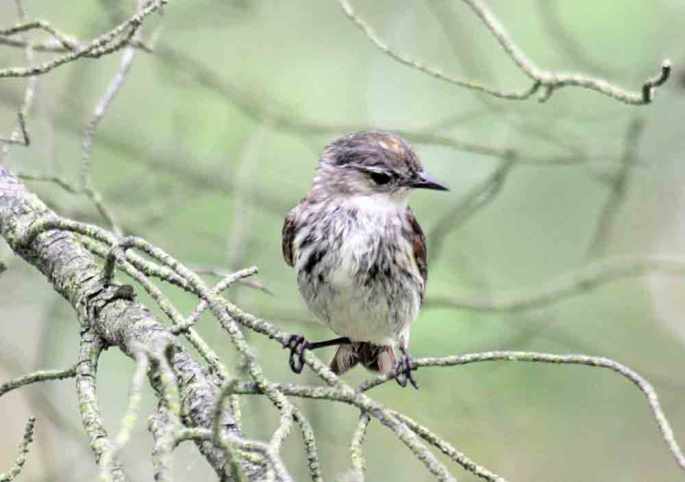Spring marches on in the dunes. Today, March 29, brought on another longshore flight to record and take note of. Just when things look to thin out, birds typical of other weeks or months are seen migrating past the longshore platform. When will spring migration actually end this year?
Today’s flight of 11,844 birds was clearly dominated by the waxwings. 11,373 Cedar Waxwings took wing over the high dunes in fast and tight flocks. The count came a few thousand birds short of beating the state record of 13,800 waxwings set right here at the Dunes State Park May 22, 2004.
In between waxwing flocks an eclectic mix of unusual birds were also found. A single American White-Pelican floated eastward over the park late morning. Kingbirds staged another good flight of 84 birds. Early and mid season warblers continue to go by. Tennessee Warbler was seen in the cottonwoods above, while a Palm Warbler fed in the Jack pines below. Just down from the tower, a lone Blackpoll Warbler could be heard singing (if you call it singing!) near the round-about.
The most interesting bird of the day was one slipped into a flock of Forster’s Terns. A presumed Arctic Tern was seen heading west off the beach. Details include a long-winged adult with small head and all white upperparts. Some gray to the belly suggestive of Common, with proportionally long tail. Add this to a third hand report of a nearby Least Tern just across the state line in Michigan and it was a very interesting tern day.
Rounding out the strange list today was the never ending onslaught of siskins. The first spring birds began March 28 and have been recorded nearly daily. Add 29 more today and we may be seeing siskins into June. We’re at 3,175 for the season. The same may be said for Red Crossbills. Another 9 flying by today gives 25 of them for the season.

Slowly entering notoriety this spring are the amazing numbers of Common Nighthawks. Since their mid-May arrival, a steady stream of nighthawks have been making near daily appearances. Late afternoon birds have been heard at many dunes area locations, and flocks are being seen feeding near the beach at dusk. Final numbers will be tallied after May 31, but early indications show this year’s numbers are 6-10 times what are normally seen during the spring. Why?

Finally, we have yesterday’s quiz bird. Truly not your expected find in late May, either in plumage or species. The photo was tentatively ID’d by the photographer and re-affirmed by three independent dune area birders. The bird certainly looks ragged. First impressions may lead one to think this may be a fledgling bird, making the record all the more significant, but in the other photos provided, one can clearly see the brown vs black wing and tail feathers, indicating this bird is undergoing a molt. A fledgling bird would have uniform flight or tail feathers.
First impressions can go along way here. The bill is that of a warbler, however it’s possible the extreme stage of molt here has exposed more of the base of the bill, making the bill appear longer and more pointed. Dull yellow splotches can be seen on the sides, under the wing. Heavy streaking can be seen on the chest, but lacking in the throat. While not complete, other features worth noting include the black legs, and small white spots on the outer tail feathers (undersides).
Don’t let the late date fool you. This is a Yellow-rumped Warbler. Interestingly, it was photographed within feet of an Orange-crowned Warbler also. the faint eye stripe at this plumage can help with taking “Audubon’s” out of contention. The even blocks of molt hint that this bird may be in it’s second year of life, but one may not know exactly without a better look at it’s wing coverts. Older birds may show more mixed patterns of molt. More importantly, it’s not a fledgling, which would be a significant breeding record for Indiana. Lastly the bird shows gray and brown tones rather than blue and black tones that would be expected on a male bird.
Final answer, Second Year Female (Myrtle) Yellow-rumped Warbler. And… spring marches on in the dunes.

